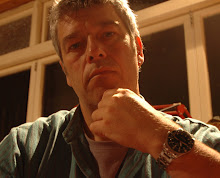BelovedArt School students visit DPAG
I visited this exhibition last Monday. Because of the restriction on photography I sketched in the gallery and added colours later. Of course I couldn’t restrict myself to a single piece so I’m going to comment on several that stand out as having some sort of relevance to my practise.
Milan Mrkursich
Construction on Red (1982)
I was immediately drawn to this work because of geometrical similarities with my pinhole solagraphs. There is the arc reaching out of the corner like the arc of the sun, the strong red ground and most prominently the skewed presentation of the canvas. These elements are all in my work also (though the skewed horizon in my work might not be so intentional). Mrkursich appears to me to be displaying a strong independent vision, abstract but highly structured. My solagraph work hovers somewhere in the abstract/representational borderlands so I am happy to make connections with Constructions on Red.
Blaise Desgoffe
Still Life (1925)
This is a masterly study of materialities. Degoff’s arrangement has reproduced the glint of burnished brass, the dull reflection of pewter, the translucence of marble etc. At the centre of this work is a small glass bust with the light entering through the back of the head and radiating a soft diffuse gleam from the face.
There is no direct relevance to specific work of mine but it seems to me to be a challenge to all photography to try to match this subtle understanding of how light plays.
JMW Turner
Dunstonborough Castle, Northumberland (1799)
I am very much a Turnerist. Whenever I have the opportunity I attempt to photograph landscapes as ferocious, awful and romantic as is this. Turner was a young man when he painted this and perhaps it shows in the less than subtle (absurdly huge?) waves endangering the boats in the midground. I also see terrible beauty in the world and seek ways to overwhelm the viewer with it.
André Derain
Un Paysage (1920?)
This is another sort of landscape, one that is soft, comfortable and easy to slip into. Although it is very much Of France it’s warm hues resemble central Otago and it is really only given away by the medieval village in the midground.
I have a vague yearning to live in a world as lovely. Creating a seductive landscape like this is an alternative to inhabiting or possessing it.
Colin McCahon
The Five Wounds of Christ, No.3 (1977-78)
This is a huge work, physically, metaphorically and emotionally. I also read this one as a landscape but unlike most landscapes, which are externalisations of the artist’s inner world, McCahon seems to bring a sort of geographical presence into his passionate vision.
Where this intersects with my practise I can’t say.
Q:Should one aspire to creating work this powerful?
Just let me keep making pretty pictures.






No comments:
Post a Comment